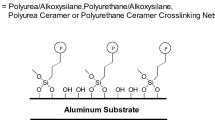Abstract
A new type of UV-curable organic–inorganic hybrid oligomer was synthesized from vinyltrimethoxysilane (VTMS), tetraethylorthosilicate, and colloidal silica (CS) using a sol–gel method. UV-curable hybrid hard coating formulations were then prepared by mixing the organic–inorganic hybrid oligomer and acrylic monomers, trimethylolpropane triacrylate and tetrahydrofurfuryl acrylate, with a levelling agent and a photoinitiator. The oligomer was hydrolyzed and condensed from alkoxysilane and CS to obtain the UV-cured hybrid films. The hybrid oligomer and resulting hybrid films were characterized by Fourier transform infrared spectroscopy, 29Si nuclear magnetic resonance spectroscopy, scanning electron microscopy, and ultraviolet–visible spectrophotometry to confirm the chemical functionality, oxo-silicon signal, cross-sectional morphology, and transparency, respectively. When the concentration of the CS/VTMS mixture in the organic–inorganic hybrid oligomer was 0.50 mol, remarkable pencil hardness (up to 5H) with excellent transparency was observed. The hardness and transparency of the UV-cured hybrid coating films were improved significantly by increasing the CS content in the organic–inorganic hybrid oligomer.









Similar content being viewed by others
References
Chujo, Y, “Organic–Inorganic Hybrid Materials.” Curr. Opin. Solid State Mater. Sci., 1 806–811 (1996)
Wen, J, Wilkes, GL, “Organic/Inorganic Hybrid Network Materials by the Sol−Gel Approach.” Chem. Mater., 8 1667–1681 (1996)
Ha, CS, Nagappan, S, Hydrophobic and Superhydrophobic Organic–Inorganic Nano Hybrids, pp. 3–4. Pan Stanford Publishing, Singapore (2018)
Faustini, M, Nicole, L, Ruiz-Hitzky, E, Sanchez, C, “History of Organic–Inorganic Hybrid Materials: Prehistory, Art, Science, and Advanced Applications.” Adv. Funct. Mater., 28 1–30 (2018)
Malucelli, G, “Hybrid Organic/Inorganic Coatings Through Dual-Cure Processes: State of the Art and Perspectives.” Coatings, 6 101 (2016)
Chang, YM, Hu, WH, Fang, WB, Chen, SS, Chang, CT, Ching, HW, “A Study on Dynamic Volatile Organic Compound Emission Characterization of Water-Based Paints.” J. Air Waste Manage. Assoc., 61 35–45 (2016)
Bretterbauer, K, Holzmann, C, Rubatscher, E, Schwarzinger, C, Roessler, A, Paulik, C, “UV-Curable Coatings of Highly Crosslinked Trimethylmelamine Based Acrylates and Methacrylates.” Eur. Polym. J., 49 4141–4148 (2013)
Çakır, M, “Investigation of Coating Performance of UV-Curable Hybrid Polymers Containing 1H,1H,2H,2H-Perfluorooctyltriethoxysilane Coated on Aluminum Substrates.” Coatings, 7 37 (2017)
Ueda, K, Kanai, H, Suzuki, T, Amari, T, “Effects of Mechanical Properties of Paint Film on the Forming of Pre-painted Steel Sheets.” Prog. Org. Coat., 43 233–242 (2001)
Moon, JI, Lee, YH, Kim, HJ, Schwartz, S, Rafailovich, M, Sokolov, J, “Investigation of the Peel Test for Measuring Self-Cleanable Characteristic of Fluorine-Modified Coatings.” Polym. Test., 31 433–438 (2012)
Dzunuzovic, E, Tasic, S, Bozic, B, Babic, D, Dunjic, B, “UV-Curable Hyperbranched Urethane Acrylate Oligomers Containing Soybean Fatty Acids.” Prog. Org. Coat., 52 136–143 (2005)
Wang, F, Hu, JQ, Tu, WP, “Study on Microstructure of UV-Curable Polyurethane Acrylate Films.” Prog. Org. Coat., 62 245–250 (2008)
Bao, F, Shi, W, “Synthesis and Properties of Hyperbranched Polyurethane Acrylate Used for UV Curing Coatings.” Prog. Org. Coat., 68 334–339 (2010)
Schwalm, R, Häußling, L, Reich, W, Beck, E, Enenkel, P, Menzel, K, “Tuning the Mechanical Properties of UV Coatings Towards Hard and Flexible Systems.” Prog. Org. Coat., 32 191–196 (1997)
He, J, Nebioglu, A, Zong, Z, Soucek, MD, Wollyung, KM, Wesdemiotis, C, “Preparation of a Siloxane Acrylic Functional Siloxane Colloid for UV-Curable Organic–Inorganic Hybrid Films.” Macromol. Chem. Phys., 206 732–743 (2005)
Derouet, D, Forgeard, S, Brosse, JC, Emery, J, Buzare, JY, “Application of Solid-State NMR (13C and 29Si CP/MAS NMR) Spectroscopy to the Characterization of Alkenyltrialkoxysilane and Trialkoxysilyl-Terminated Polyisoprene Grafting Onto Silica Microparticles.” J. Polym. Sci. Part A Polym. Chem., 36 437–453 (1998)
Mauger, M, Dubault, A, Halary, JL, “Synthesis and Physico-Chemical Characterization of Networks Based on Methacryloxypropyl-Grafted Nano-Silica and Methyl Methacrylate.” Polym. Int., 53 378–385 (2004)
Mahadik, SA, Mahadik, DB, Parale, VG, Wagh, PB, Gupta, S, Rao, AV, “Recoverable and Thermally Stable Superhydrophobic Silica Coating.” J. Sol-Gel Sci. Technol., 62 490–494 (2012)
Hwang, Y, “High-Transmittance Films From Silica Colloidal Nanoparticles.” J. Korea Ceram. Soc., 41 (10) 766–770 (2004)
Ha, CS, Jung, SJ, Kim, ES, Kim, WS, Lee, SJ, Cho, WJ, “Properties of UV-Curable Polyurethane Acrylates Using Nonyellowing Polyisocyanate for Floor Coating.” J. Appl. Polym. Sci., 62 1011–1021 (1996)
Choi, WC, Lee, WK, Ha, CS, “Synthesis and Properties of UV-Curable Polyurethane Acrylates Based on Different Polyols for Coating of Metal Sheets.” Mol. Cryst. Liq. Cryst., 660 104–109 (2018)
Acknowledgments
This research was financially supported by the Ministry of Trade, Industry and Energy, Korea, through the Industry Core Technology Development Program (No: 10070142) and Brain Busan 21 Plus Program. The work was also supported by the National Research Foundation of Korea (NRF) Grant funded by the Ministry of Science and ICT, Korea (NRF-2017RIA2B3012961) and Brain Korea 21 Plus Program (21A2013800002).
Author information
Authors and Affiliations
Corresponding author
Rights and permissions
About this article
Cite this article
Choi, WC., Kim, SH., Lee, WK. et al. UV-curable organic–inorganic hybrid hard coatings for metal sheets. J Coat Technol Res 16, 771–780 (2019). https://doi.org/10.1007/s11998-018-00154-6
Published:
Issue Date:
DOI: https://doi.org/10.1007/s11998-018-00154-6




